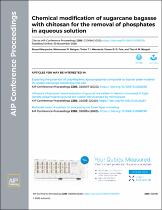 ResearchSpace
ResearchSpace
Recent progress in the structural modification of chitosan for applications in diversified biomedical fields
JavaScript is disabled for your browser. Some features of this site may not work without it.
- ResearchSpace
- →
- Research Publications/Outputs
- →
- Journal Articles
- →
- View Item
Recent progress in the structural modification of chitosan for applications in diversified biomedical fields
https://www.sciencedirect.com/science/article/pii/S0014305718307031
https://doi.org/10.1016/j.eurpolymj.2018.10.013
http://hdl.handle.net/10204/10770
https://doi.org/10.1016/j.eurpolymj.2018.10.013
http://hdl.handle.net/10204/10770
This article critically reviews the recent developments in the structural modifications of chitosan and its nano-structured variants produced via different techniques and their potential applications in diversified biomedical fields such as tissue engineering, drug delivery, wound healing, and gene therapy. Chitosan, a unique cationic polysaccharide, is derived from chitin, a material extracted from the shells of crabs and other sea crustaceans using alkaline deacetylation. The main advantage of using chitosan for different biomedical applications is that its properties can be tailored according to the end-use application. Moreover, it can be easily functionalized into different derivatives through chemical, radiation, and enzymatic methods. Over the last decade, polysaccharide-based functional biomaterials have been used as new drug delivery systems and highly efficient scaffolds for regenerative medicine. Because of their excellent biocompatibility, non-toxicity, antimicrobial, antifungal, and antitumor activities, chitosan-based materials in various forms, such as composites, nanoparticles, and hydrogels, have been used as scaffolds for tissue engineering. This is a highly diversified and interdisciplinary research field requiring expertise in carbohydrate chemistry, polymer synthesis, gene therapy, cell culturing, tissue engineering, stem cell research, and therapeutic cloning. Chitosan-based hydrogels and micro/nanoparticles have also been used in designing new therapeutic systems. Therefore, in this review article, we have summarized the chemical structure and biological properties of chitosan and the state-of-the-art methods used for chitosan modification and functionalization to design solutions for a wide range of biomedical applications.
Reference:
Mittal, H. et al. 2018. Recent progress in the structural modification of chitosan for applications in diversified biomedical fields. European Polymer Journal, vol. 109: 402-434
Mittal, H., Ray, S. S., Kaith, B., Bhatia, J., Sukriti, Sharma, J., & Alhassan, S. (2018). Recent progress in the structural modification of chitosan for applications in diversified biomedical fields. http://hdl.handle.net/10204/10770
Mittal, Hemant, Suprakas S Ray, BS Kaith, JK Bhatia, Sukriti, J Sharma, and SM Alhassan "Recent progress in the structural modification of chitosan for applications in diversified biomedical fields." (2018) http://hdl.handle.net/10204/10770
Mittal H, Ray SS, Kaith B, Bhatia J, Sukriti, Sharma J, et al. Recent progress in the structural modification of chitosan for applications in diversified biomedical fields. 2018; http://hdl.handle.net/10204/10770.
Copyright: 2018 Elsevier. Due to copyright restrictions, the attached PDF file only contains the abstract of the full text item. For access to the full text item, please consult the publisher's website: https://www.sciencedirect.com/science/article/pii/S0014305718307031
Dec 2018
Chitosan
Grafting of chitosan
Chitosan nanoparticles
Biomedical applications of chitosan
Tissue engineering
Drug-delivery
Wound-healing
Pharmaceuticals
Grafting of chitosan
Chitosan nanoparticles
Biomedical applications of chitosan
Tissue engineering
Drug-delivery
Wound-healing
Pharmaceuticals
Files in this item
Related Items
This item appears in the following Collection(s)
Related items
Showing items related by title, author, creator and subject.
-
Author: Midya, L ; Das, R ; Bhaumik, M ; Sarkar, T ; Maity, Arjun ; Pal, S Date: Apr 2019 Water contamination owing to the presence of toxic organic chemicals/heavy metals are considered to be one of the serious global environmental issues. Various advanced polymeric materials have been developed and used for the separation/removal ... Read more
-
Author: Mokhena, Teboho C ; Luyt, AS Date: Jul 2017 The aim of this study was to develop a high flux three-tier composite membrane composed of a coating layer based on chitosan and chitosan with silver nanoparticles, electrospun alginate nanofibres as a midlayer and nonwoven as a mechanical ... Read more
-
Author: Manyatshe, Alusani ; Balogun, Mohammed O ; Nkambule, TTI ; Cele, Zamani ED ; Msagati, TAM Date: Nov 2020 Sugarcane bagasse is the major solid waste product of the sugarcane industry. As a plant-derived biomass, it is an attractive environmentally friendly alternative to petroleum-based materials. Being a non-food agriculture product, its use as ... Read more
Browse
-
All of ResearchSpace
-
This Collection
Legislation and compliance
General Enquiries
Tel: + 27 12 841 2911
Email: callcentre@csir.co.za
Physical Address
Meiring Naudé Road
Brummeria
Pretoria
South Africa
Postal Address
PO Box 395
Pretoria 0001
South Africa
Copyright © CSIR 2017. All Rights Reserved
Resources on this site are free to download and reuse according to associated licensing provision. Please read the terms and conditions of usage of each resource.







